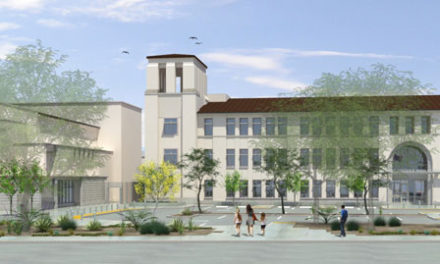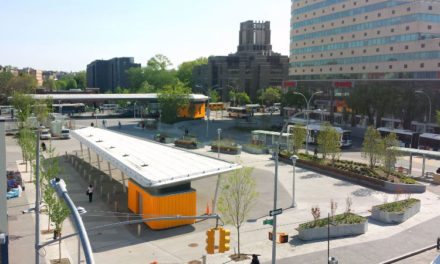Columbia University Medical Center (CUMC) announced that its new, state-of-the-art medical and graduate education building will be named the Roy and Diana Vagelos Education Center. The building, dedicated June 9th on the CUMC campus in Northern Manhattan, will be officially open and in use in August 2016.
The Vagelos Education Center, designed by the New York-based interdisciplinary design studio Diller Scofidio + Renfro in collaboration with Gensler as executive architect, is a 100,000 square-foot, 14-story glass tower that incorporates technologically advanced classrooms, collaboration spaces, and a modern simulation center to reflect how medicine is taught, learned, and practiced in the 21st century. The design seeks to reshape the look and feel of the Medical Center, and also create spaces that facilitate the development of skills essential for modern medical practice.
Construction began in September 2013, with an initial lead gift from P. Roy Vagelos, MD, a distinguished alumnus of Columbia’s College of Physicians and Surgeons (P&S), and his wife, Diana Vagelos, an alumna of Barnard College and the Vice Chair of the Trustees of Barnard College. The Vagelos Education Center was funded through the generosity of many committed friends, faculty and alumni donors.
“We are training the doctors who will deliver medical care, the scientists who will perform groundbreaking scientific research, and the teachers who will help train the future generation of physicians and scientists. It is important that their educational facilities are as exciting as medical science is today,” said Dr. Vagelos.
“We are so grateful for Roy and Diana’s dedication to Columbia, not only through their own generous gift for this important new education building, but also the inspiration they provide to others,” said Columbia President Lee C. Bollinger. “They are joined in this enduring commitment by Philip and Cheryl Milstein who have long supported so many parts of the university, from Morningside Heights to the Medical Center, and Mary Jaharis and the late Michael Jaharis and their family, for their long-established engagement with the Medical Center and this project. Because of their collective efforts we are adding another of several new architectural jewels on our campuses.”
In addition to the new Vagelos Education Center, initiatives to revitalize the campus include adding green space, creating a new gateway to the medical school, consolidating student services, renovating several existing buildings, and constructing new spaces, including the new home for the Columbia School of Nursing. The Vagelos Center will help define the northern edge of the campus and provide a bridge to the surrounding Washington Heights community.
“Our new education building will ensure that Columbia continues to train superior doctors and researchers, educated in the latest techniques, as medicine continues to evolve rapidly throughout the 21st century,” said Lee Goldman, MD, Executive Vice President and Dean of the Faculties of Health Sciences and Medicine at Columbia University. “The building also will allow us to centralize key activities in a state-of-the-art facility that reflects our commitment to providing world-class instruction and a superb learning environment for students.”
About the Design of the Roy and Diana Vagelos Education Center
“Space matters for structured and informal learning,” said Elizabeth Diller, founding partner at Diller Scofidio + Renfro. “To support Columbia’s progressive medical education program, we designed a building that will nurture collaboration. Its defining feature is the Study Cascade–a 14-story network of vertically linked spaces in a variety of sizes, both focused and social, private and communal, indoors and out.”
The Roy and Diana Vagelos Education Center is a 14-story glass, concrete, and steel structure defined by the “Study Cascade”—a network of social and study spaces distributed along an exposed, interconnected vertical staircase that extends the height of the building—and encompasses 100,000 square feet of state-of-the-art medical and scientific facilities. The alcove interiors of the Study Cascade, designed to be conducive to collaborative, team-based learning and teaching, open onto south-facing outdoor spaces and terraces. Other key elements of the design include:
- Ground floor lobby and café, which adjoin a “study bar” with views of the Palisades
- Student Commons, which features a café, computer work area and computer labs
- Advanced clinical simulation center, a specialized space for mock examination rooms, clinics and operating rooms
- Multi-purpose auditorium, a 275-seat flexible space used for campus-wide events such as lectures, screenings and concerts
- “Academic Neighborhoods,” groups of classrooms that can be configured according to need by operable partitions, drop down screens and large-scale multi-user touch screens, suspended ceilings, and distributed power and data at the floor
- South and West Courts, outdoor spaces featuring local plant species
- Anatomy Quad, a flexible learning space with integrated screens and task lighting
“The Vagelos Education Center started with a clear vision as a place of excellence for higher learning that would also act as a much needed social center,” said Maddy Burke-Vigeland AIA, Principal at Gensler. Because of everyone’s deep involvement, it has transformed into something that exceeds even those high expectations: a vibrant new hub for Columbia’s Medical Center Campus.”
DS+R’s design takes advantage of an incredible view of the Hudson River and the Palisades. The building also integrates a range of sustainable features—including locally sourced materials, green roof technologies, and an innovative mechanical system that minimizes energy and water use—and the façade features ceramic “frit” patterns that are baked onto the exterior glass to diffuse sunlight. All new construction and renovation projects—including the Vagelos Education Center—work toward the goal of minimizing CUMC’s carbon footprint and reducing greenhouse gas emissions by 30% by 2025.
For more information about the building, visit The Roy and Diana Vagelos Education Center.
For more images of the building, please visit: http://newsroom.cumc.columbia.edu/blog/2016/06/10/columbia-university-medical-center-dedicates-roy-diana-vagelos-education-center-2/
About Columbia University Medical Center
Columbia University Medical Center provides international leadership in basic, preclinical, and clinical research; medical and health sciences education; and patient care. The medical center trains future leaders and includes the dedicated work of many physicians, scientists, public health professionals, dentists, and nurses at the College of Physicians and Surgeons, the Mailman School of Public Health, the College of Dental Medicine, the School of Nursing, the biomedical departments of the Graduate School of Arts and Sciences, and allied research centers and institutions. Columbia University Medical Center is home to the largest medical research enterprise in New York City and State and one of the largest faculty medical practices in the Northeast. For more information, visit cumc.columbia.edu or columbiadoctors.org.
About Diller Scofidio + Renfro
Diller Scofidio + Renfro is an interdisciplinary design studio that integrates architecture, the visual arts, and the performing arts. The New York City-based studio established its identity through independent, theoretical, and self-generated projects, and has realized over 60 art/architecture projects around the world including the High Line and the redevelopment of Lincoln Center for the Performing Arts, both in New York City; The Broad Museum in Los Angeles; and curatorial works and installations exhibited at leading cultural institutions. Founding partners Diller and Scofidio are recipients of the MacArthur Foundation’s “genius” award, the first given in the field of architecture.
About Gensler
Gensler is a global architecture, design, and planning firm with 46 locations and more than 5,000 professionals networked across Asia, Europe, Australia, the Middle East and the Americas. Founded in 1965, the firm serves more than 3,500 active clients in virtually every industry. Gensler designers strive to make the places people live, work and play more inspiring, more resilient, and more impactful. For more information, visit our website or blog, follow us on Instagram and Twitter or like us on Facebook.
SOURCE Columbia University Medical Center
See Connecting a Medical School to its Community: The Roy and Diana Vagelos Education Center at Columbia University by Maddy Burke-Vigeland, AIA, LEED® AP of Gensler.





